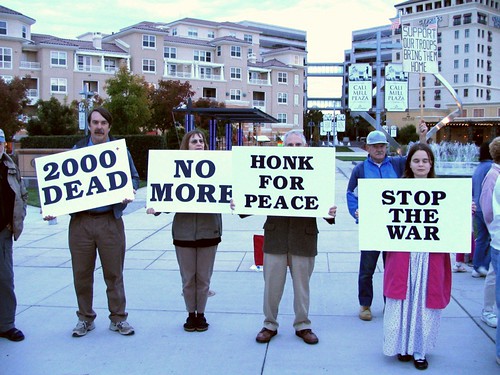 Activism
Activism - the process of taking peaceful, direct, or militant action to achieve a political or social goal.
That's the simple definition of activism. What's more difficult to explain is why certain people feel led to give their time, energy, and sometimes blood and lives to a cause. What special characteristic do they have that makes them set their individual needs aside for the advancement of a group or an idea?
In many cases the change they are working for will directly benefit the activist or someone they care about. An event has touched them so deeply they feel they must act. Not to act in the face of injustice would be more of a crime than a simple arrest for protesting on private property. Ruffling a few feathers is a small sacrifice for the greater good that might be achieved.
Activists are sometimes painted as radicals, malcontents, or social outcasts who will never be content. But then time passes and we (the masses) begin to see the fruits of the activist's labor. Think about these examples for a moment.

This is a picture of Joan Norman, famous in Oregon for protesting against logging companies. She took her lawn chair and sat in the way of the trucks to protect an old growth forest. "I want my grandchildren to know what it's like to walk among 800 year old trees. A tree shouldn't just be a picture in a book."
Joan recently died at the age of 72 in a head on car collision. She wanted to leave behind a legacy for change, a memory of someone who didn't stand by and watch as the world she loved "went to pot".
Cesar Chavez once said, "I am convinced that the truest act of courage, the strongest act of manliness is to sacrifice ourselves for others in a totally non-violent struggle for justice." Chavez was instrumental in changing and improving the working conditions of migrant workers in the grape
vineyards of California. He founded a labor union so the workers could
organize and have a voice against the vineyard owners. As a
Mexican-
American migrant worker who toiled along side his family after they lost their Arizona ranch during the depression, he became the face of the migrant worker.

Protests like the ones led by Chavez and Martin
Luther King Jr. are one form of activism. There are other ways, as demonstrated by
Bono, Angelina Jolie, and many others who do not have the advantage of a high profile career. These people use their time and resources to throw themselves into the conflicts or social injustices they wish to change. They live the concept of One Voice, Strong Voice, using whatever means are available to them to bring about positive change.
Email campaigns, petitions, meetings on Internet Virtual Realities such a Second Life, attending city council meetings with a group of
like minded folks are ways to let your voice be heard. Use the power of your vote to let our government know what matters to you, not just in national elections but on the local level, too.
Our country is divided about so many issues but that is okay. We are a diverse society of many cultures and concerns. The important thing is that we care. We exercises our right to voice our individual views and to organize protests against injustice.
If you are so inclined....act. In the words of
Gandhi, "Action may not always bring happiness; but there is no happiness without action.
 Masahisa Goi, founder of The Peace Pole Project, wants you to know this... If you fling all of your thoughts into these simple words, and, from this prayer keep living your lives anew, before you know it your individualistic or cliquish feelings will diminish, and you will feel humanitarian love welling up from within. Gradually, the individual's character will be approaching wholeness, and the person's lifestyle will strike a harmonious note - which is the greatest thing an individual can do for world peace.
Masahisa Goi, founder of The Peace Pole Project, wants you to know this... If you fling all of your thoughts into these simple words, and, from this prayer keep living your lives anew, before you know it your individualistic or cliquish feelings will diminish, and you will feel humanitarian love welling up from within. Gradually, the individual's character will be approaching wholeness, and the person's lifestyle will strike a harmonious note - which is the greatest thing an individual can do for world peace. These poles serve to remind us to keep peace alive in our thoughts, words and actions every day.
These poles serve to remind us to keep peace alive in our thoughts, words and actions every day.


































 For centuries humans passed down mythology, oral histories, and sage advice around the campfire at night. As our society became more techonological, more isolated and less tribal the art of storytelling gave way to reading books, watching television, and
For centuries humans passed down mythology, oral histories, and sage advice around the campfire at night. As our society became more techonological, more isolated and less tribal the art of storytelling gave way to reading books, watching television, and